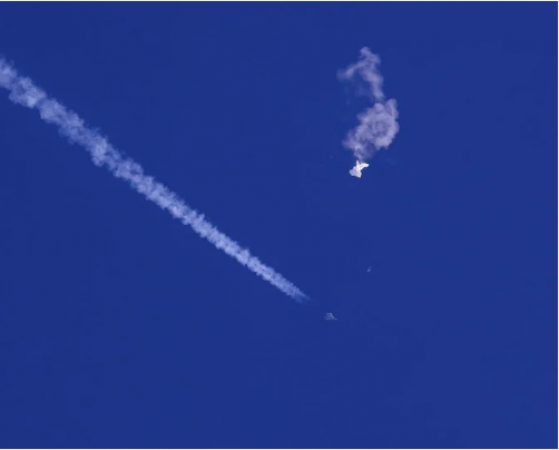
Washington: The US Coast Guard on Monday established a temporary safety zone in waters off South Carolina while the military searched for and recovered fragments of a suspected Chinese spy balloon that was shot down by a US fighter jet.
The White House claimed that the balloon's flight over the United States had not eased already strained relations with China and that Beijing's claim that the balloon was being used for meteorological purposes was implausible.
In response to the downing of the balloon, Beijing is urging Washington to exercise restraint. White House spokesman John Kirby told reporters, "Nobody wants to see conflict here."
Also Read: UN chief worries that a larger war is about to break out
As a result of the balloon's entry into US airspace last week, US Secretary of State Antony Blinken postponed his scheduled visit to China on 5 and 6 February. It was shot down off the coast of the Atlantic on Saturday.
According to Kirby, Blinken will attempt to reschedule the tour when the time is right. The trip to Beijing will mark the first by a US secretary of state since 2018, as the US and China have worked to mend their strained ties on a range of issues, including a plan to deny China access to some cutting-edge technologies. America's effort is also included. ,
Kirby said that in order to gather as much information as possible about the balloon's operation, officials hope to retrieve many of its components. The United States was able to study the balloon while it was in the air.
The shooting of the balloon was referred to by China as an "apparent overreaction". Vice Foreign Minister Xie Feng said in remarks to the US Embassy in Beijing published on the ministry's website that "China firmly opposes and opposes it."
While a successful recovery could potentially give the US insight into China's espionage capabilities, US officials have downplayed the balloon's impact on national security.
Also Read: Devastating earthquakes in Turkey and Syria claim 4300+ lives
The White House claimed that three balloon flights from China took place during Donald Trump's time in office. Senior US officials have offered to pass on details of those flights to former Trump administration officials.
The senior US general in charge of bringing down the balloons claimed on Monday that there was an "awareness gap" in the military's ability to identify spy balloons before the balloons appeared over the US on January 28.
The head of the US North American Aerospace Defense Command and Northern Command, General of the Air Force Glenn VanHerk, however, claimed to have discovered the earlier flights based on "additional means" of information without US intelligence.
Providing any further information about whether those additional tools may include human sources, telephone intercepts or cyber espionage.
According to Mao Ning, a spokesman for the Chinese Foreign Ministry, China was informed by Washington that its balloon had flown over the country.
According to the statement, the unintentional entry of this airship (in the US) was a singular, accidental event. He added that it tests the sincerity of the US in managing crises as well as enhancing and stabilizing bilateral relations.
unmanned civilian airship on a test flight that "severely deviated and inadvertently entered the space over Latin America because it was affected by weather and because its self-steering capability is limited," according to Mao, another balloon was the source of what was seen above. Continent.
After the Pentagon reported on Friday that a second Chinese balloon was flying over Latin America, Colombia's military said on Sunday that it had seen a balloon-like object in the air.
China has threatened "serious consequences" and said it will take necessary measures to handle "similar situations", while urging the US to exercise restraint.
However, some policy analysts said they expect any response to be carefully calibrated to avoid worsening diplomatic relations even further.
According to brokerage ING the event could spark a "technological war", and would be bad for the Chinese yuan in the near future.
Also Read: 'Loophole' justifies alleged misconduct by WHO officials
"More export restrictions on technology from various industries will likely be implemented by both sides. While the risk of logistical disruption from COVID sanctions has now disappeared, it poses a new threat of supply chain disruption," it said.
According to ING, "this new risk is more a long-term risk than an immediate one."